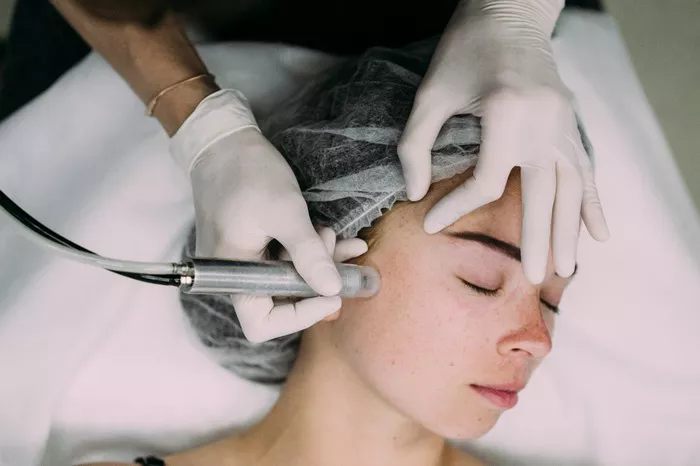Microdermabrasion is a popular skin treatment that can help to improve the appearance of the skin. This non-invasive treatment is designed to exfoliate the top layer of dead skin cells, revealing smoother, brighter skin underneath. While microdermabrasion can be beneficial for many different skin types, there are certain skin types that may benefit the most. In this article, we will explore which skin types are best suited for microdermabrasion.
What is Microdermabrasion?
Microdermabrasion is a non-invasive skin resurfacing treatment that uses a special device to exfoliate the skin. The device typically uses tiny crystals or a diamond-tipped wand to remove the top layer of dead skin cells. This process helps to stimulate the production of collagen and elastin, which can help to improve the texture and tone of the skin.
Microdermabrasion is typically performed in a dermatologist’s office or medical spa. During the treatment, the device is passed over the skin, exfoliating the top layer of dead skin cells. The treatment is painless and requires no downtime, making it a popular option for people with busy schedules.
Skin Types That Benefit from Microdermabrasion
Aging Skin
As we age, our skin naturally loses collagen and elastin, which can lead to fine lines, wrinkles, and sagging skin. Microdermabrasion can help to stimulate the production of these important proteins, which can help to improve the texture and tone of aging skin. Additionally, the exfoliating action of microdermabrasion can help to reduce the appearance of fine lines and wrinkles by removing the top layer of dead skin cells.
Sun-Damaged Skin
Exposure to the sun’s harmful UV rays can cause damage to the skin, including sun spots, hyperpigmentation, and uneven skin tone. Microdermabrasion can help to improve the appearance of sun-damaged skin by removing the top layer of dead skin cells and stimulating the production of collagen and elastin. This can help to reduce the appearance of sun spots and hyperpigmentation, and improve the overall texture and tone of the skin.
Acne-Prone Skin
Microdermabrasion can also be beneficial for people with acne-prone skin. The exfoliating action of microdermabrasion can help to unclog pores and remove excess oil and debris from the skin. This can help to reduce the frequency and severity of breakouts, and improve the overall appearance of acne-prone skin.
Dull, Tired Skin
If your skin is looking dull and tired, microdermabrasion can help to give it a boost. By removing the top layer of dead skin cells, microdermabrasion can reveal brighter, more radiant skin underneath. This can help to improve the overall appearance of your skin and give you a more youthful, refreshed look.
Oily Skin
If you have oily skin, microdermabrasion can be a great option for you. The exfoliating action of microdermabrasion can help to remove excess oil and debris from the skin, which can help to reduce the appearance of oiliness and prevent breakouts. Additionally, microdermabrasion can help to improve the texture and tone of oily skin, giving it a smoother, more refined look.
Rough, Uneven Skin
If your skin is rough and uneven, microdermabrasion can help to smooth it out. The exfoliating action of microdermabrasion can help to remove the top layer of dead skin cells, revealing smoother, more even skin underneath. This can help to improve the overall texture and tone of your skin, giving it a more polished, refined look.
Dry Skin
While microdermabrasion may not be the first treatment that comes to mind for people with dry skin, it can actually be very beneficial. The exfoliating action of microdermabrasion can help to remove the top layer of dead skin cells, which can help to improve the absorption of moisturizers and other skincare products. Additionally, microdermabrasion can help to stimulate the production of collagen and elastin, which can help to improve the texture and tone of dry skin.
Sensitive Skin
If you have sensitive skin, you may be hesitant to try microdermabrasion. However, there are certain types of microdermabrasion that are designed specifically for sensitive skin. These treatments use gentler exfoliants and are performed at a lower intensity, which can help to avoid irritation and redness. If you have sensitive skin, it’s important to consult with a skincare professional to determine whether microdermabrasion is the right option for you.
Conclusion
Microdermabrasion is a versatile skin treatment that can benefit many different skin types. Whether you have aging skin, sun-damaged skin, acne-prone skin, dull, tired skin, oily skin, rough, uneven skin, dry skin, or sensitive skin, microdermabrasion can help to improve the appearance of your skin. If you are considering microdermabrasion, it’s important to consult with a skincare professional to determine whether it is the right option for you. With the right treatment plan and aftercare, you can achieve smoother, more radiant skin.


